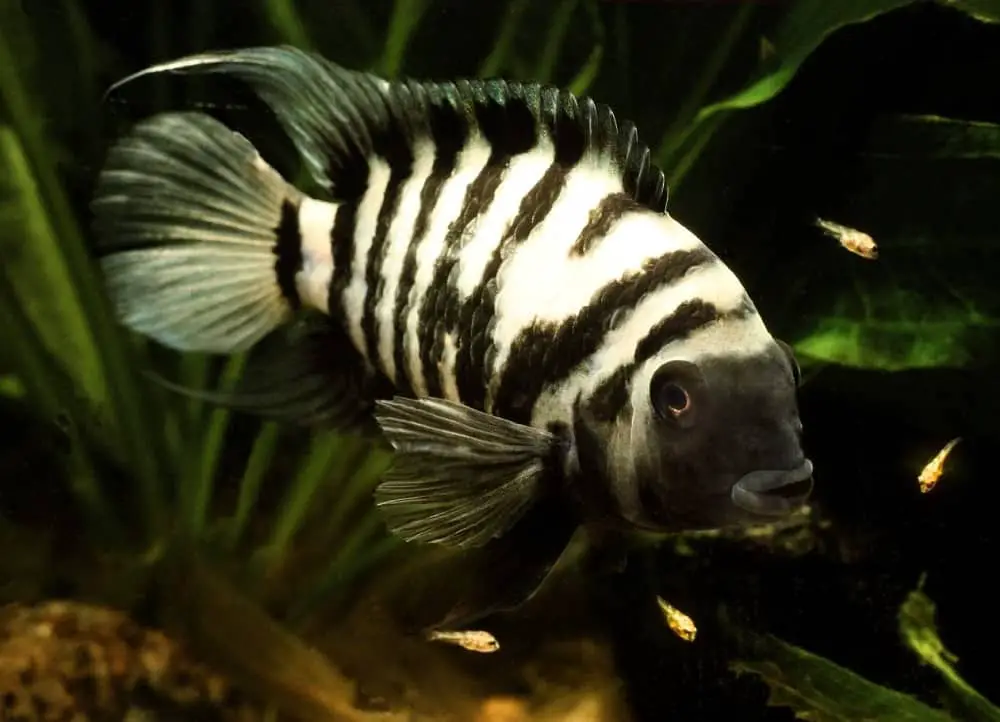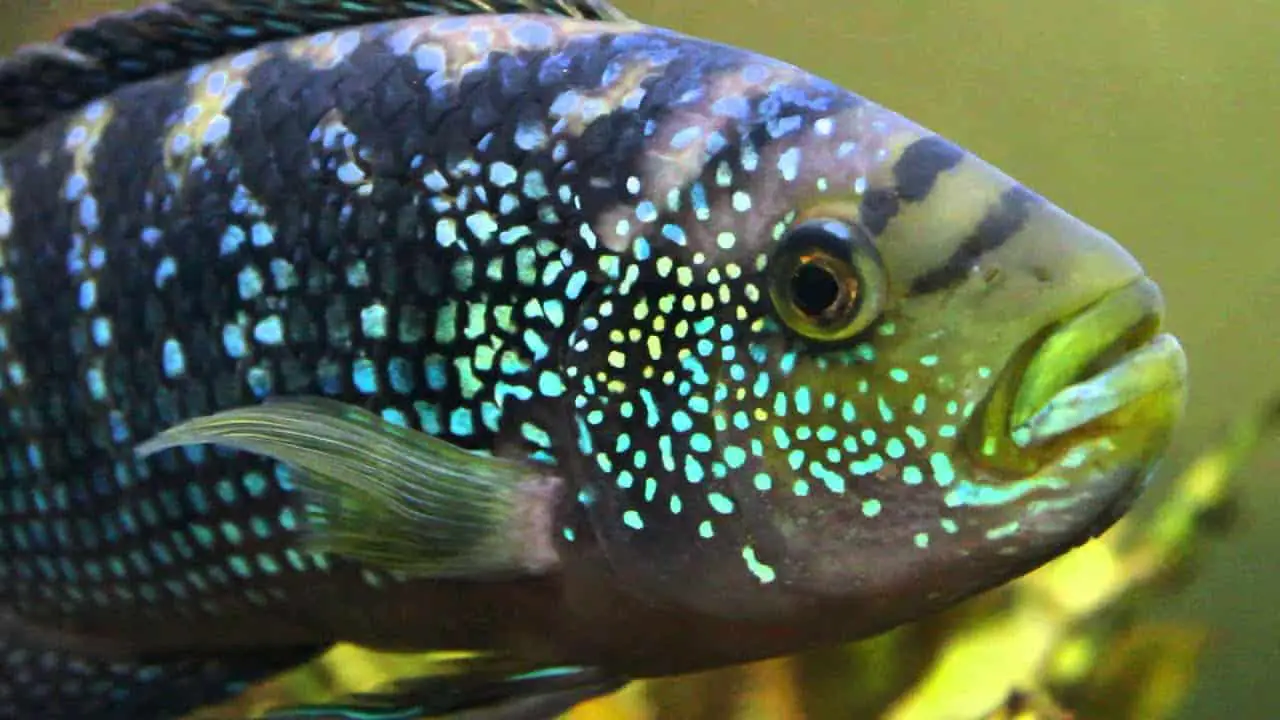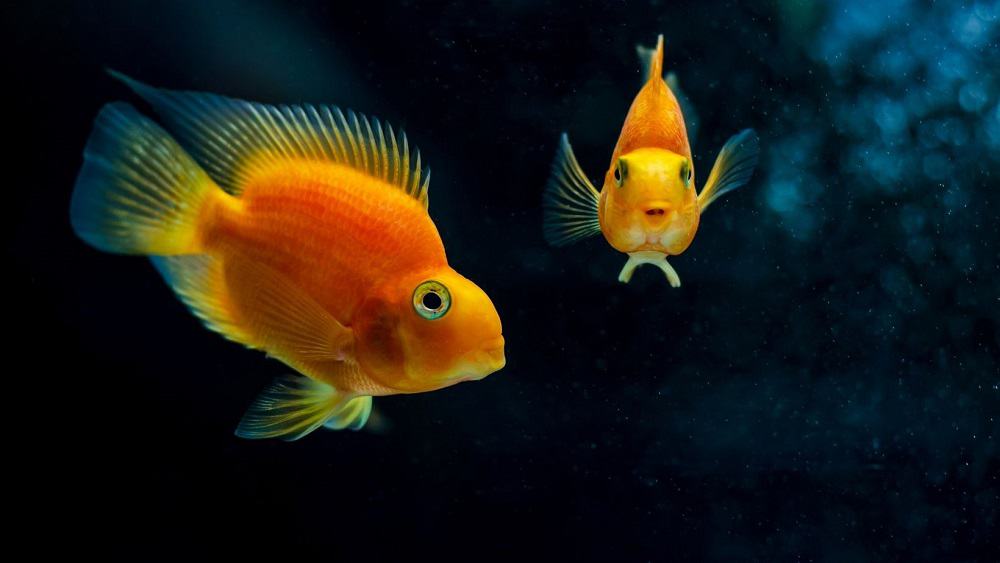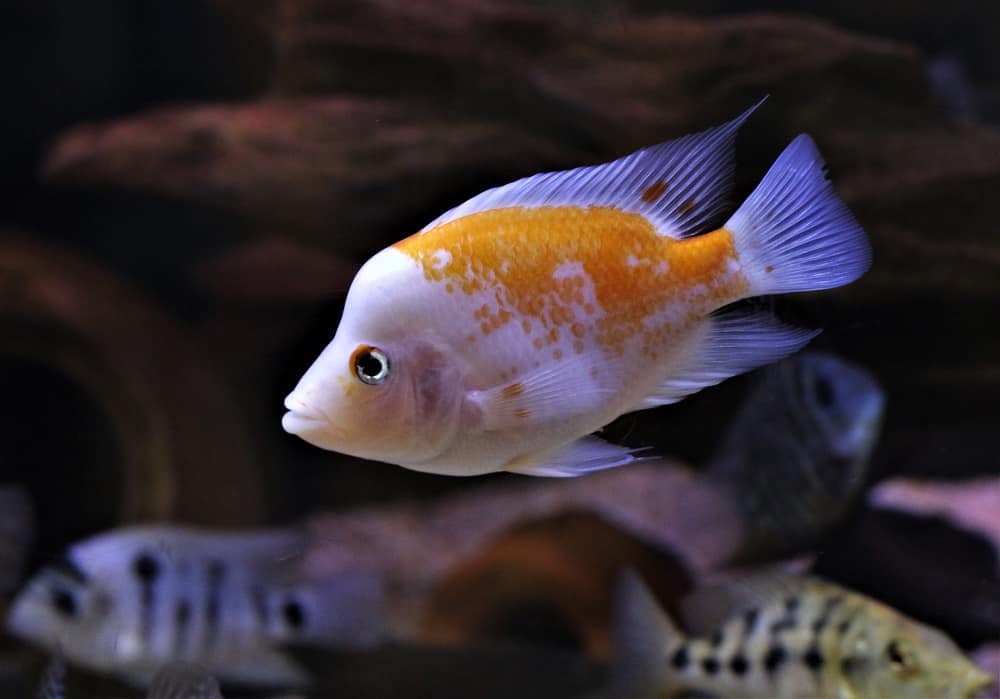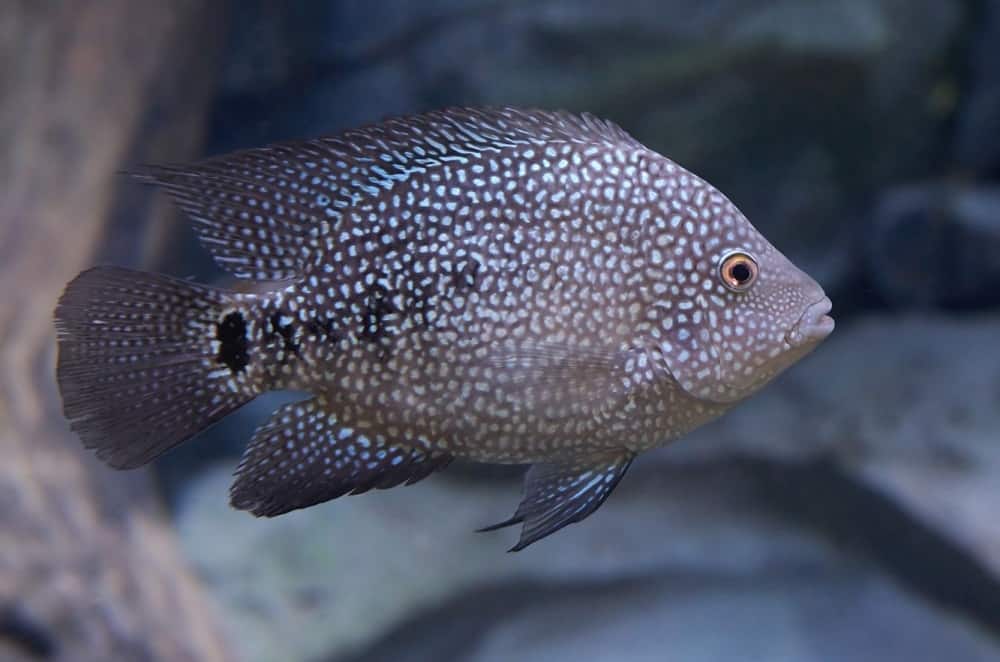Have you ever seen a Venustus Cichlid? If you have, we’re sure you thought to yourself, “Wow, that is one good-looking fish!” And you’re right; it is stunning.
The spots on the golden body of the Venustus Cichlid are what give this fish its popular name, “Giraffe Cichlid”. But the Venustus Cichlid (Nimbochromis venustus) is more than just a pretty face. They are also very hardy freshwater fish suitable for a wide range of water parameters, making them an excellent choice for aquarists of all experience levels.
Additionally, wild-caught specimens of this fish are pretty rare, so if you’re looking to add one to your collection, you’re better off going with a captive-bred fish. Trust us, and you won’t be disappointed.
Species Summary
The Venustus Cichlid is native to the Rift Valley in Africa. These fish are found in Lake Malawi, where they inhabit sandy regions, open water, and near rocky areas.
This fish is a member of the Cichlidae family, which is known for its intelligence. The Venustus Cichlid is a cunning predator that likes to bury itself in the sand and wait for small fish to come by. As soon as its prey is within reach, the Venustus Cichlid will quickly grab it.
Most specimens are bred in captivity, and although very rare, Venustus Cichlids collected from nature are still found. And while they may seem like a delicate species, they’re pretty hardy and can thrive in various conditions. They’re an excellent choice for aquarists who already have experience with alkaline water fish tanks, as they can be susceptible to some changes in water parameters.
Venustus Cichlid Care Guide
These fish are very hardy but can’t live in a regular community tank. Venustus cichlids require a bit more care than other fish, but they are well worth the effort.
Tank Size
Venustus Cichlids can grow to be large fish, so they need an aquarium with reasonable space. The minimum size aquarium for a small group of these fish should be 26 gallons, with dimensions of at least 60″ x 20″ x 15″.
Tank Mates
While they are beautiful fish, they can be difficult to keep in an aquarium because of their aggressive nature. They are known to be territorial and will often attack and kill other fish they perceive as a threat. They should therefore be kept with fish that are of similar size and aggression level.
Avoid keeping Venustus cichlids with smaller fish, as they may be attacked and eaten. Likewise, avoid keeping them with peaceful cichlids, as they will likely be harassed or killed.
Some good tank mates for Venustus cichlids include Clown Loaches, Nimbochromis livingstonii, Frontosa, Red Empress (Protomelas taeniolatus), and Dimidiochromis compressiceps.
Same Species Tanks
They thrive in biotope-type aquariums that mimic their natural habitat.
Keep in mind that Venustus Cichlids are very territorial and will attack and kill any other male of the same species unless the aquarium is enormous. But if you’re up for the challenge, they make a great addition to any well-decorated aquarium.
Water Parameters
These fish are incredibly resistant and can tolerate a wide range of water parameters, as long as you keep the pH on the alkaline side. However, they are highly susceptible to pollutants in the water, so it’s important to keep your aquarium clean.
The perfect temperature for keeping Venustus Cichlids is 75-82 degrees Fahrenheit. The ideal pH range is between 7.8 and 8.6, and the hardness should be 10-18 dH.
What to Put in Their Tank
When it comes to keeping your Venustus Cichlid healthy, there are a few key things to keep in mind. First and foremost, you’ll need a good aquarium heater and filtration system. The filtration system should be well-sized and create a moderate flow. Additionally, these fish enjoy a well-lit aquarium.
As with most African cichlids, the Venustus cichlid needs plenty of hiding places in its tank. This is because these fish live in rocky areas with lots of places to hide from predators in the wild.
You can provide hiding places for your Venustus Cichlid by adding rocks and other decorations to their tank. Just be sure to secure the rocks so that they don’t fall and hurt your fish.
Another important aspect of keeping Venustus cichlids is providing them with plenty of open space to swim. In the wild, these fish live in open waters and need room to move around. Be sure to leave plenty of space in their tank for them to swim and explore.
Common Diseases
Like most Rift Lake Cichlids, they are susceptible to Malawi bloat and acidosis. These are common diseases in cichlids that originate from the same region as the Venustus. Malawi bloat is caused by a bacterial infection, and acidosis is caused by a high pH level in the water.
Food and Diet
The Venustus Cichlid is a carnivore; in the wild, its diet consists mainly of smaller fish.
These fish will readily accept all types of food in an aquarium, but a good diet for them should include a combination of high-quality commercial feed, live, fresh, or frozen foods such as bloodworms and brine shrimp or daphnia.
It’s important to set a feeding schedule for your Venustus Cichlids and always give them an amount of food that they can consume quickly. These fish are always hungry, so a varied and high-quality diet is essential for them to demonstrate their full potential.
Lifespan
In captivity, a Venustus cichlid can live up to 10 years with the proper care. However, these fish don’t usually live as long in the wild due to diseases, predators, and other environmental factors.
Appearance
The Venustus Cichlid, also called the Giraffe Cichlid, is a beautiful and popular fish in the aquarium world. As its name suggests, the Venustus Cichlid is known for its elongated and robust body shape, which is typical of the cichlids found in Lake Malawi.
One of the most distinguishing features of the Venustus Cichlid is its protruding mouth, which is adapted for feeding on smaller fish. In addition to its large mouth, the Venustus Cichlid also has prominent dorsal, anal, pectoral, and pelvic fins, each of which is equipped with small spines that are used for defense and during disputes with other fish.
Adult male Venustus Cichlids are particularly striking, with bright blue heads and golden yellow bodies covered with mottled markings resembling camouflage. Juvenile Venustus Cichlids are silver in coloration, with irregular dark spots and a yellow line that runs along the fish’s underside, from the gill to the anal and caudal fins. This yellow line becomes more pronounced as the fish ages.
Size
The Venustus Cichlid can quickly grow to 2.9 inches in length when well cared for and fed.
Behavior and Temperament
The Venustus cichlid is a beautiful but aggressive tropical fish. If you’re thinking of adding one to your aquarium, there are a few things you need to know first.
This fish is a voracious predator and must be kept in a suitably sized tank with other fish of the same size and behavior. They are very active and will occupy all tank levels, but they like to have hiding places among the decorations.
Venustus is known for its aggression towards fish of similar shape and color. Unlike other African cichlids, this fish is solitary, so there’s no need to keep it in a harem.
Some aquarists report that this fish becomes even more aggressive when it’s kept in an unsuitable environment. Despite being solitary, the Venustus seems to do best in a group consisting of one male and several females.
Breeding
Venustus Cichlid is a polygamous fish, meaning you must breed a male with several females.
Mating takes place in a place previously chosen by the couple, and the male attracts the female in a ritual of movements. The female will lay the eggs in a spot on the ground (usually a surface such as a rock), and the male will then fertilize.
Being a buccal incubator, the female places the eggs in her mouth for hatching, at which point the male can be taken out of the aquarium.
The female will carry between 60 to 120 eggs for over a month and allow hatched fry to hide in her mouth for up to 10 days. The fry feeds easily on commercial rations.
Gender Differences: Male vs Female
The Venustus cichlid is sexually dimorphic, meaning that the males and females of the species exhibit different physical traits.
The adult male is slightly larger and exhibits a more striking coloration than the adult female, showing blue coloration on the head, which intensifies during the breeding season — just as the yellow color on the top of the head, dorsal, and anal fin.
Venustus Cichlid Fun Facts
● Its scientific name Nimbochromis, comes from the Latin, nimbus = stormy, rainy + Greek, and Chromis, a fish. Venustus, From the Latin “Venustus” = beautiful, graceful, elegant.
● As fore mentioned, it is an ambush predator in the wild, often found motionless amid rocky structures, thickets of plants, or at the bottom of the lake.
● Sedentary and often playing dead, this adaptation is known as thanatosis. It serves as a defensive means in other animals, while in fish, it is adapted for offensive means. When a smaller fish tries to take advantage of the situation and lunges at the supposed corpse, Venustus will swallow it. The yellow coloration on the head and dorsal fin serve as an attraction for its prey.
● It belongs to a group commonly known as Peacock cichlids or Haps. Like all peacock cichlids, it has an extraordinary coloration that is only demonstrated after about one to two years of life.
References.
Konings, A., 1990. Ad Konings’s book of cichlids and all the other fishes of Lake Malawi. T.F.H. Publications, Inc.
Maréchal, C., 1991. Protomelas. p. 387-393. In J. Daget, J.-P. Gosse, G.G. Teugels and D.F.E. Thys van den Audenaerde (eds.) Check-list of the freshwater fishes of Africa (CLOFFA). ISNB, Brussels; MRAC, Tervuren; and ORSTOM, Paris.
Snoeks, J. and J. Manuel, 2004. The genus Nimbochromis Eccles & Trewavas, 1989. p. 57-85. In Snoeks, J. (ed.) The cichlid diversity of Lake Malawi/Nyasa/Niassa: identification, distribution and taxonomy. Cichlid Press, El Paso, USA.

